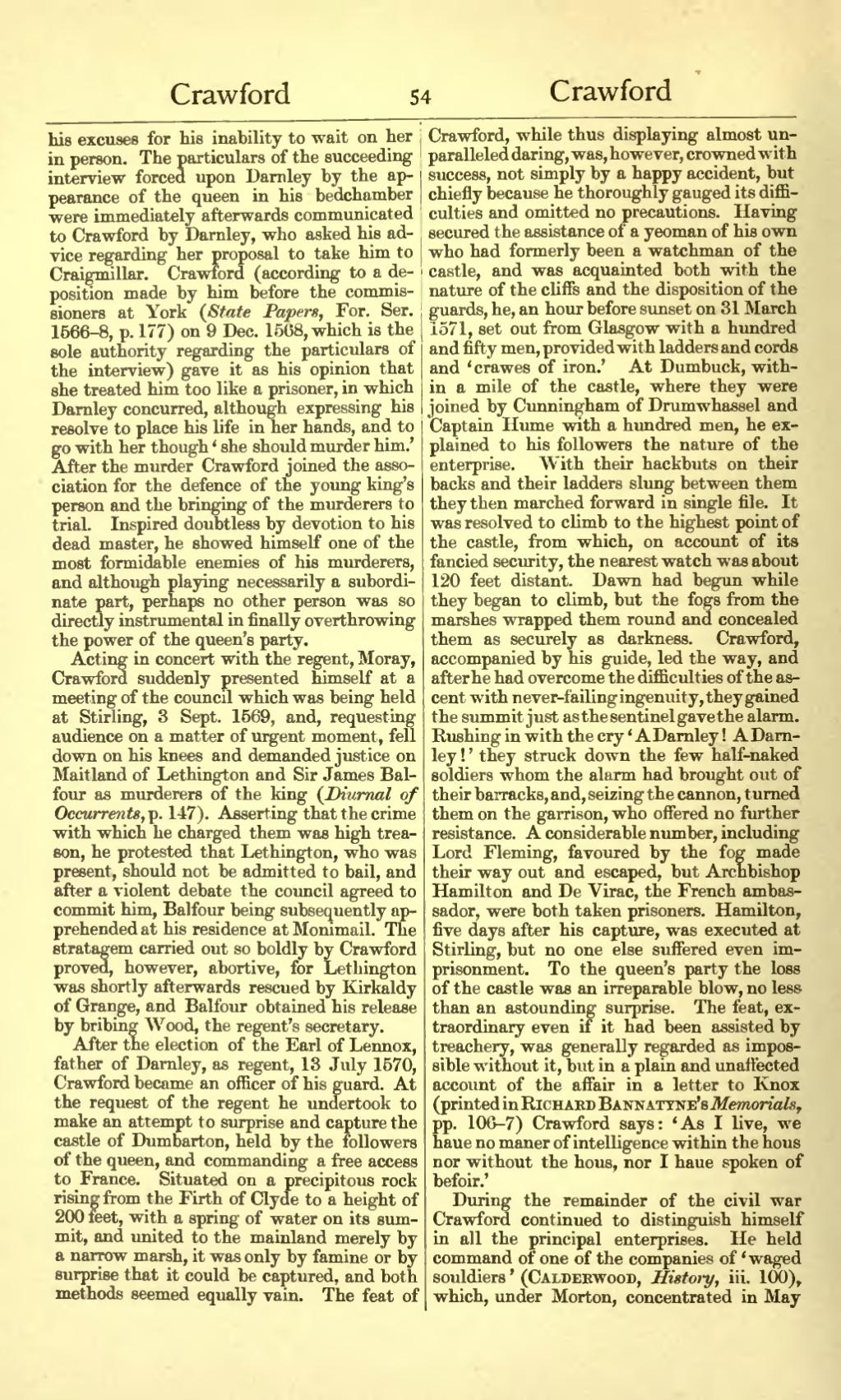his excuses for his inability to wait on her in person. The particulars of the succeeding interview forced upon Darnley by the appearance of the queen in his bedchamber were immediately afterwards communicated to Crawford by Darnley, who asked his advice regarding her proposal to take him to Craigmillar. Crawford (according to a deposition made by him before the commissioners at York (State Papers, For. Ser. 1566–8, p. 177) on 9 Dec. 1568, which is the sole authority regarding the particulars of the interview) gave it as his opinion that she treated him too like a prisoner, in which Darnley concurred, although expressing his resolve to place his life in her hands, and to go with her though ‘she should murder him.’ After the murder Crawford joined the association for the defence of the young king's person and the bringing of the murderers to trial. Inspired doubtless by devotion to his dead master, he showed himself one of the most formidable enemies of his murderers, and although playing necessarily a subordinate part, perhaps no other person was so directly instrumental in finally overthrowing the power of the queen's party.
Acting in concert with the regent, Moray, Crawford suddenly presented himself at a meeting of the council which was being held at Stirling, 3 Sept. 1569, and, requesting audience on a matter of urgent moment, fell down on his knees and demanded justice on Maitland of Lethington and Sir James Balfour as murderers of the king (Diurnal of Occurrents, p. 147). Asserting that the crime with which he charged them was high treason, he protested that Lethington, who was present, should not be admitted to bail, and after a violent debate the council agreed to commit him, Balfour being subsequently apprehended at his residence at Monimail. The stratagem carried out so boldly by Crawford proved, however, abortive, for Lethington was shortly afterwards rescued by Kirkaldy of Grange, and Balfour obtained his release by bribing Wood, the regent's secretary.
After the election of the Earl of Lennox, father of Darnley, as regent, 13 July 1570, Crawford became an officer of his guard. At the request of the regent he undertook to make an attempt to surprise and capture the castle of Dumbarton, held by the followers of the queen, and commanding a free access to France. Situated on a precipitous rock rising from the Firth of Clyde to a height of 200 feet, with a spring of water on its summit, and united to the mainland merely by a narrow marsh, it was only by famine or by surprise that it could be captured, and both methods seemed equally vain. The feat of Crawford, while thus displaying almost unparalleled daring, was, however, crowned with success, not simply by a happy accident, but chiefly because he thoroughly gauged its difficulties and omitted no precautions. Having secured the assistance of a yeoman of his own who had formerly been a watchman of the castle, and was acquainted both with the nature of the cliffs and the disposition of the guards, he, an hour before sunset on 31 March 1571, set out from Glasgow with a hundred and fifty men, provided with ladders and cords and ‘crawes of iron.’ At Dumbuck, within a mile of the castle, where they were joined by Cunningham of Drumwhassel and Captain Hume with a hundred men, he explained to his followers the nature of the enterprise. With their hackbuts on their backs and their ladders slung between them they then marched forward in single file. It was resolved to climb to the highest point of the castle, from which, on account of its fancied security, the nearest watch was about 120 feet distant. Dawn had begun while they began to climb, but the fogs from the marshes wrapped them round and concealed them as securely as darkness. Crawford, accompanied by his guide, led the way, and after he had overcome the difficulties of the ascent with never-failing ingenuity, they gained the summit just as the sentinel gave the alarm. Rushing in with the cry ‘A Darnley! A Darnley!’ they struck down the few half-naked soldiers whom the alarm had brought out of their barracks, and, seizing the cannon, turned them on the garrison, who offered no further resistance. A considerable number, including Lord Fleming, favoured by the fog made their way out and escaped, but Archbishop Hamilton and De Virac, the French ambassador, were both taken prisoners. Hamilton, five days after his capture, was executed at Stirling, but no one else suffered even imprisonment. To the queen's party the loss of the castle was an irreparable blow, no less than an astounding surprise. The feat, extraordinary even if it had been assisted by treachery, was generally regarded as impossible without it, but in a plain and unaffected account of the affair in a letter to Knox (printed in Richard Bannatyne's Memorials, pp. 106–7) Crawford says: ‘As I live, we haue no maner of intelligence within the hous nor without the hous, nor I haue spoken of befoir.’
During the remainder of the civil war Crawford continued to distinguish himself in all the principal enterprises. He held command of one of the companies of ‘waged souldiers’ (Calderwood, History, iii. 100), which under Morton, concentrated in May
